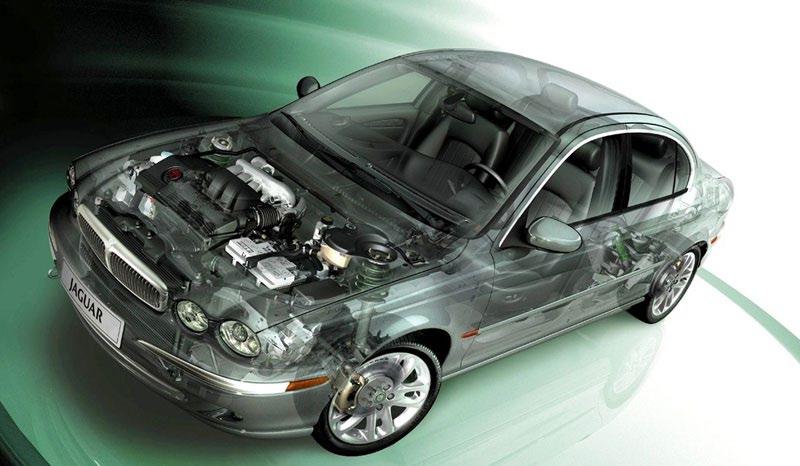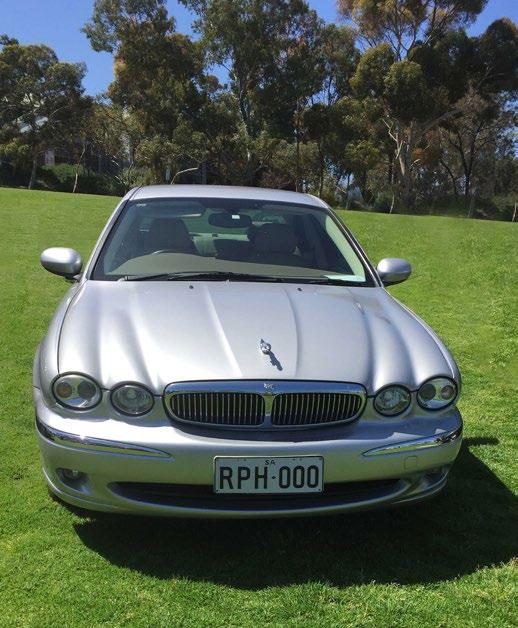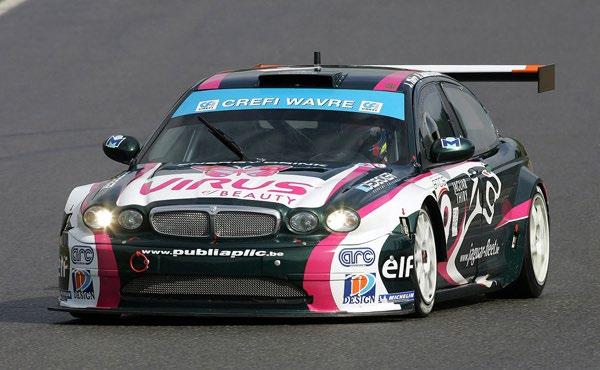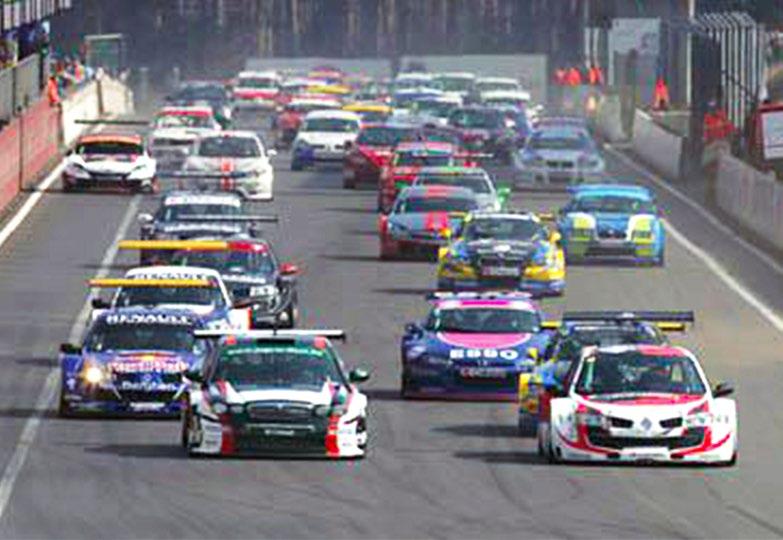
20 minute read
CONTENTS (Feature Articles) Feature X-Type (2001-2009
Ray Smithers & Judy Langdon, 2009 (2010 MY) Maroon X-Type Auto. This ‘facelift’ model saw the X-Type receive new bumpers front and rear, more discreet side rubbing mouldings, deeper sills, full width rear plinth and a new grille. The grille used the same moulded plastic ‘chunky’ mesh design as the XF and facelifted XJ and a similar badge, now planted in the middle.
In the new millennium small executives had become the rage, and so in March 2001 Jaguar launched its most ambitious car, a new compact executive saloon to battle the BMW 3 Series, Audi A4 and Mercedes C-class.
The problem was that Jaguar did not have a competitive platform. Therefore, the X-type used a modified version of the front-drive Ford CD132 platform shared with the Ford Mondeo with the addition of all-wheel drive.
Design
The X-Type took the greatest number of design cues from the XJ, mostly the forthcoming X350. However, in order to find its own identity, the X-Type used smaller, elliptical headlamps to widen the appearance and appear sleeker, being too tall and narrow at the front to pull off the XJ’s traditional front. This made the rearward front axle a little more obvious. The bonnet was traditional Jaguar, heavily fluted and quite long to maintain some Jaguar presence. Although at the time designers talked about the ‘cab-forward’ proportions becoming the modern trend, much effort was expended to fairly successfully conceal the longer front overhang and visually increased the distance between the front wheels and the A-posts. The design of its wide radiator grille and quad-headlights work beautifully and, like other Jaguars, the X-Type has the look of an athletic cat. Inside there was traditional leather-and-timber interiors. The X-Type broke new ground in that it was Jaguar’s: - • first station wagon/estate car, • would ultimately introduce Jaguar’s first diesel engine, • introduced Jaguar’s first four-cylinder engine since 1949 and • became Jaguar’s first front-wheel and all-wheel drive configuration. The X-Type was not a simply re-bodied version of the Mondeo, although sadly this would be label applied to the X-Type later in life. In terms of prestige, this really shouldn’t have been an issue. The Audi A4 front wheel drive had been co-developed with Volkswagen’s Passat and shared far more with each other than had the X-Type and Mondeo. Strange then that the Mondeo was the class leader, not the Passat, yet being Mondeo related was somehow seen as undesirable. While many disliked the idea of a somehow ‘less-pure’ Jaguar, there were many advantages using an existing platform such as increased development resources in terms of manpower and finance, and economies of scale. The X-Type at launch was solely fourwheel drive. The design brief imposed, meant that the X-Type had to feel like any other Jaguar. The only reasonable way to achieve this was with a rear biased allwheel-drive set up. The car was powered by more-or-less the same V6 installed in the mid-size S-Type and would go on to power future XJs and the XF. The design brief insisted the X-Type should have the best steering of any AWD or FWD car ever created and should handle neutrally to give the perception of an extraordinarily stable RWD vehicle. To do this, the X-Type used a unique front suspension system including twin tube dampers, with exemplary torsional stiffness to ensure the steering remained as uncorrupted as possible, always a problem with driven front wheels.
Less Mondeo and more X-Type
The front suspension system was conceptually not dissimilar to that of the Mondeo, but was completely tailored to suit the X-Type, sharing nothing. The steering system itself was a ZF Servotronic II system that helped counter previous criticism of overly assisted, overly light steering on Jaguar cars. (continued page 8)

The rear suspension was far more closely related to the Mondeo, whilst the front system was un-recognisable compared with the original Ford set up. The rear system was taken from a Mondeo Estate. Some may have felt this was something of a cop-out by Jaguar, but the system was available, affordable, capable and allowed Jaguar to fulfil its comfort and refinement ambitions without compromise. The platform itself was no simple carryover, either, the 2000 Mondeo had no AWD system to accommodate and, although some panels such as front strut tops were identical, most bore no resemblance. Furthermore, the wheelbases of the two cars did not match, nor did their lengths, widths or tracks.
Safety Features
The X-Type went on to achieve a four-star NCAP crash rating and did so through clever body design that incorporated impact absorbing crash and shear structures, as well as high strength steels such as in the A-post screen pillars and other clever design features such as the telescopic steel prop shaft. The X-Type utilised the same occupancy detection and evaluation systems as the other Jaguar cars, whereby the weight and position of the occupant was categorised by the car’s crash computing systems and decided how exactly to best inflate the front airbags. If the system believed there was a child, the airbags would not detonate with the same force as for a full-size adult, and if the weight of the occupant fell below a 50kg threshold, the passenger airbag would be disabled entirely. In addition, front seat occupants were further protected by side airbags in the seats to protect thorax and upper body, whilst standard airbags located in the head rails protected both front and rear seat passengers. Later cars also received driver knee protection airbags. ABS braking was fitted and supplemented by electronic brake force distribution that transferred braking effort from front to rear depending on whether or not the vehicle was cornering, and emergency brake assist, increasing the assistance given to the driver in an emergency braking situation.
Engine and Transmission
For the X-Type a 3.0 litre version of the same Jaguar AJ-V6 as used in the S-Type was ideal, but the engine would now have to be placed transversely, leading to alterations and repositioning of the engine’s accessories, air intake and exhaust systems. A 2.5 litre AJ-V6 was also simultaneously developed from the 3.0 litre engine. The trouble was that this engine was down on power and torque but was not significantly more economical (27mpg combined for 3.0, 29mpg for 2.5) as it had to be worked harder, and was every bit as expensive to build. The original 2.5 litre and 3.0 litre AWD models were followed in 2002 by an even more affordable 2.1 litre front-wheel drive model, still with a V6 engine. During 2003, a four-cylinder 2.0-litre turbodiesel was introduced followed by a 2.2-litre diesel in June 2004. All engines were initially available with either five- speed automatic or five speed manual gearbox.
(continued page 9)
The X-Type at launch was solely a four-wheel drive car. The design brief imposed meant that the X-Type had to feel like any other Jaguar. The only reasonable way to achieve that was with a rear biased all-wheel-drive set up. The car was powered by (more-or-less) the same V6 as installed in the mid-size S-Type that would go on to power future XJ’s and the XF.

The launch of the Jaguar X-Type at the Geneva Motor Show, March 2001. The all-wheel-drive system gave the X-Type extraordinary stability, making it resistant to both under and oversteer in dry conditions and trustworthy in the wet.

Top tech for an entry-level Jaguar
The X-Type became the first Jaguar to feature xenon HID head-lamps. Other features and options included tenspeaker audio systems, heated front windscreen, auto-dimming mirrors, automatic headlights and electric memory heated seats all made their ways onto the specification lists throughout the range (most of which would become standard with age), as did the latest antilock braking system, 32-bit transmission control management (automatic models) and Denso 32-bit engine control management (again, completely different to that of the sister Mondeo). Much of the technology on board would be transferred to the rest of the range. Much of the switchgear such as window control packs, overhead consoles, and even the door mirrors would find its way onto the X150 XK and X350 XJ over the next few years. If anything, this was all a little embarrassing, the cheapest car in the range was easily the most advanced, not to mention the most practical with the largest boot, S-Type matching accommodation, and performance (in 3.0 litre guise).
Interior
The interior was far more closely aligned with the X300/308 and X350 XJ than to the then current S-Type and, at the time, was praised as such. Materials, even artificial ones, were used in natural ways to imply a sense of effortless luxury for the X-Type’s occupants, and enabled the X-Type to feel far more exclusive and extravagant than the solid but uninspired plasticky interiors of the rivals. True to tradition, only genuine wood was deployed inside, much to the chagrin of the manufacturing engineers and accountants. Fillets of veneer were also placed on higher model’s door casing, further increasing the development and production costs. The interior was very much centred on ‘olde-worlde’ charm which in later years did little to enhance the X-Types reputation but the switchgear was of good quality and would be rolled out across the rest of the range in time, and there were no Ford parts in sight. Despite the old-fashioned interior architecture, the latest in technology was utilized. More modern options such as dark stained wood, aluminium and carbon fibre trims helped to boost the cars credentials that were not available at launch. Base models would be offered with stodgy cloth, small wheels, no steering wheel mounted controls and manual heating controls, even losing the requisite armrest and rear electric windows.
Extensive Testing
The car was tested globally, from subzero temperatures, snow-clogged roads, desert terrain, potholed roads of Britain, to high speed rings in Italy. Millions of miles of development ensured the X-Type would be well judged and dependable on the road. During this time, most electrical gremlins were ironed out.
Launch
Initial reaction to the X-Type was positive, the motoring press loved the styling, less controversial than the preceding S-Type. Ride quality in even the sport models was first class and it was clear that Jaguar had given much thought to long-distance comfort.
(continued page 10)
Most comments regarding the Mondeo sister-car were positive, citing just how capable that car also was and, in the end, that just 19% of the car’s origins were shared. Jeremy Clarkson, then of BBC’s Top Gear, lauded the X-Type, especially the 4×4 and sport versions and in two episodes, he demonstrated its capabilities in the snow. With regards to the sharing of the Ford Mondeo platform, Clarkson states that this should not put you off, stating that “genetically you are 98% identical to a halibut, but it’s the 2% that makes the difference”. Other car magazine and website reviews were largely positive for the X-Type, especially during its introduction.
The estate was well received in Europe and was essentially a new car from the B-pillars rearward in terms of visual design and upper-body engineering. Many felt it was, in fact, better proportioned than the saloon.

X-Type Estate (pre-facelift)
The Estate was the first Jaguar model designed by Ian Callum. From its saloon counterpart, the design revised 420 tooled parts and 58 stampings for all components rearward of the windscreen, adding 70 kg.

The design used a tailgate with independently-opening, strut-supported rear window, operable by key fob or dashboard located switch; roof-mounted luggage rails in chrome or black; interior luggage tie-downs; removable luggage cover; cargo net and a cargo compartment under the rear floor with a 12-volt power outlet and below that, storage for a full-size spare tyre. The rear seats could be lowered without removing their headrests, and the cargo compartment offered 16 cubic feet up to the side windows or 24 cubic feet to the headliner, with the rear seats up — or a total of 50 cubic feet with the rear seats folded. The Estate was marketed as the Sportwagon in the United States.
Special Editions
In 2004, the Spirit limited model based on the 2.5 litre V6, featured the ‘Sports Collection’ pack with new spoilers and rear valance. It was followed in 2005 by the XS limited edition, which continued the sports theme, but available with a wider range of engines.
Development and Stagnation
With no further development, the X-Type was left to suffer at the hands of rivals in the marketplace. (continued page 11)
The car that had carried so much hope and had been so extensively engineered and tested was now derided as little more than a re-shelled Ford Mondeo. The 2.0D and five-door variants had helped sales a little, but this was a Jaguar purist’s nightmare, a front-wheel drive, manual, diesel estate.
2008 (2009 MY) Facelift
By the latter half of the decade, sales of X-Type were slow but fairly stable. The fairly pointless 2.1 litre V6 variant was quietly dropped, soon after followed by the 2.5, leaving just the four-cylinder turbodiesel and the 3.0 V6. However, the 2009 Facelift brought a raft of changes. A fairly low cost but surprisingly comprehensive refresh programme saw the X-Type receive new bumpers front and rear, more discreet side rubbing mouldings, deeper sills, full width rear plinth and a new grille. The grille used the same moulded plastic ‘chunky’ mesh design as the XF and facelifted XJ and a similar badge, now planted in the middle. The changes on the exterior were relatively minor with no new sheet metal, but effectively differentiated the new model with the existing car whilst the changes inside and ‘under-the-skin’ were more numerous.

Ros Holland, 2005 Silver X-Type Auto. Initial reaction to the X-Type was positive. The motoring press loved the styling and rated the ride quality in even the sport models as first class and that it was clear that Jaguar had given much thought to long-distance comfort. Australian Jaguar Magazine’s 100th Edition put the ‘new’ X-Type to the test and noted its sensational engineering and quality control, but that the heart of the X-Type was its handling and driving stating that they had never driven a luxury car with such incredible capabilities.
New seat trims and patterns, including a quilted and soft-grain leather, and new door panels were introduced and many new wood or other material veneer options, as well as felt lined door pockets in the front doors. Revised dials also ensured the revised interior was at least visually more expensive. Under the bonnet, engine revisions saw the newer 2.2 litre turbodiesel mated to an automatic, six-speed, complete with a Tiptronic-style sequential manual mode, and with a new more conventional shifter in addition to its six-speed manual. The 3.0-litre petrol automatic continued as before and was the last Jaguar to ever feature the classic J-gate. Amazingly, the barely revised AJ-V6 continued passing EU emissions laws into the 2010’s.
TATA Motors
At the beginning of 2008, Jaguar was rocked with the announcement that Jaguar Land Rover would be sold by Ford to Tata. The revised X-Type carried on quite successfully, earning its keep in emerging markets as well as providing honest income as an affordable and reliable luxury executive for fleet users in more traditional markets. The recession of 2008 also worked in the X-Types favour, more expensive cars were out of reach and offers on the proven X-Type were quite generous, the diesel engines were very frugal and sales actually increased. On 18 December, 2009, the last X-Type rolled off the production line at Halewood.
At the time, with no direct replacement, JLR sacrificed its footing in the small luxury executive saloon and estate marketplace. Overtime the X-Type would be shunned by various senior figures in the business, slated in the press by any journalist looking to rehash the usual clichéd badge-engineering jibes and leaving mixed impressions in the public, usually those negative, belonging to armchair experts with no experience of the X-Type. .


As noted in previous editions of Classic Marque, the Queen has owned a number of Jaguars including one of the last built X-Type Estates. The range green Jaguar X-Type Sovereign came with heated seats, parking sensors and a dog grille to stop the corgis distracting the driver. The Queen was often pictured driving the V6 X-Type around Windsor but eventually decided to part with the car. Despite being seven years old, the threelitre automatic X-Type had just 7,600 miles on the clock at the time of sale. In 2016, London-based car firm Fletchdale Ltd was involved in the sale and said the new owner did not know who the previous owner was nor that they were buying the Jaguar from her Majesty herself. Fletchdale said that “the new owner unknowingly bought a slice of royalty.” The X-Type Estate sold for the bargain basement price of £15,000. .
In 2016 the Queen sold her 2009 Jaguar X-type 3.0 litre Estate complete with heated seats, parking sensors and a dog grille. With just 7,600 miles on the clock, the ONE owner car, driven by a little old lady, sold at the bargain price of just £15,000

The Queen pictured driving with a security guard in the Jaguar X-Type down Long Walk in Windsor Great Park. The monarch is the only person permitted to drive down Long Walk and is also the only person allowed to drive without a licence in the UK. Seen here, her Majesty had to move off the Long Walk to avoid a young family, who were reportedly stunned when they realised who the driver was.



Almost immediately after the launch of the X-Type, an X-Type R was always a consideration. Conceptually, the X-Type R deviated little from the formula of the other Jaguar ‘R’ saloons. It used a supercharger strapped to the 3.0 litre AJ-V6 producing upwards of 300bhp and with a 0-60 km per hour time in the 5.0 second range thanks to a six-speed gearbox and 4WD traction. Jaguar built several prototypes through its Special Vehicle Operations (SVO) Department starting with a standard production specification X-Type. The design included wider tracks with wider tyres wrapped around 19-inch alloy road wheels. For production this would have required retooling for new wing panels. Additional stiffness was also required in the engine bay to cope with the extra power. Visually the car had slatted vents in the bonnet to draw more air into the supercharger and had more aggressive sills, front and rear bumper additions and the aforementioned larger diameter wheels as well as visually more imposing exhaust finishers.
2003 Jaguar X-Type R Supercharged V6 SVO prototype. In 2008 it was gifted to the Jaguar Daimler Heritage Trust. The number plate relates to the X-Type’s project number ‘X400’.
During testing, it had been established that the transfer case mechanism for the 4WD wasn’t the most robust system and, whilst perfectly adequate on a wellkept 3.0 litre, it was not up to the job of reliably taming the substantial boost of the supercharger. With investment, this could have been addressed. The X-Type R was set to be a stunning car, but ultimately the investment dried up. Ford had become disillusioned with X-Types inability to dominate the market place. The X-Type R and other X400 variants were abandoned to the archives. Because an estate car was able to accommodate slightly bigger wheels (18 inch), a supercharged estate car was built and used for development testing throughout 2004-2005. In 2008 it was gifted to the Jaguar Daimler Heritage Trust. .

The X-Type R prototypes were reportedly developed around another prototype. This X-Type sports sedan was built in 2002 to explore options for Jaguar racing in North America. “Rocketsports Racing”, who were competing in the Trans-Am series with a lightweight Jaguar XKR built the X-Type. Engineers widening the X-Type’s track by over eight inches and modified the body with race-style wheel arches joined longitudinally by aerodynamic rocker box sections. At the front, there’s a deeper spoiler while at the rear a full-width, racing-style wing was mounted on the boot. “Rocketsports” continued racing the XKR and the concept of racing X-Type’s was taken up by European racing teams.

You might not think the X-Type has any kind of competition history, but, in 2005, it won the competitive Belgian Touring Car Series.
The winning car, entered by Thiry Racing International (TRI) from Luxembourg, was a ‘Silhouette’ – a light-weight, tubular-frame chassis X-Type powered by Jaguar’s 3.0-litre V6 with a six-speed Hewland sequential gearbox. The car was built for TRI by the Belgian racing car specialist Motorsport International, based in Theux. It was the brainchild of Albert Thiry, a Jaguar dealer from Habay-la-Neuve, Luxembourg. The car won its first race, the final round of the 2003 Belgian Touring Car Series at Spa-Francorchamps, resulting in an attack on the Championship in 2004. Following a win at Zolder, TRI was suddenly the team to drive for. In 2005, it entered a second car for the pairing of Vincent Radermecker and Jérôme Thiry; and David Dermont and Bernard Delhez. With the best drivers,

Between 2003 and 2009 several motosport racing teams ran lightweight X-Type Jaguars in the Belgium Touring Car Series (BTCS), amassing numerous podium finishes.
a lucrative sponsorship from Kodak count on us to do everything we can to and a competitive car, Albert Thiry was stand on the top step of the podium.” unashamedly aiming for success. “Like all the other advanced teams,” he said at the start of the season, “we can affirm that the victory at Zolder last year gave us a taste for champagne and you can The season started well with a second place at Spa-Francorchamps for Radermecker and Thiry, followed by a win at Dijon for Delhez and Stéphane

Lémeret, the Belgian driver and journalist who won the BTCS in 2004 and who was standing in for Dermont. Following fifth place and fastest lap for Thiry and Radermecker at the 12 Hours of Spa in July, and a month later at the same circuit, the pair won two shorter sprint races. “We are now back in third place in the Championship, not far from the leaders,” said Thiry afterwards. “We can once again believe in the title.” The pair won the 25 Hours VW Fun Cup at Spa-Francorchamps and came second at the double-header again at the Belgian circuit a month later, moving them up into second place in the Championship behind the Porsche 911 996 GT3-RS drivers, Frédéric Bouvy and David Loix. Following a two-race meeting at Zolder in September, the Jaguar drivers went into the final race of the season at SpaFrancorchamps a mere 9.5 points behind the leaders. Thiry finished second in the first race behind an Audi A4 Silhouette and Radermecker as runner-up in the second race of the meeting gained enough points to make the pair 2005 BTCS Champions. A great reward for the team and for Jaguar. It was a fabulous result for and gave the X-Type some much-needed publicity on the continent.

The win prompted other teams to develop their own X-Types for the BTCS. Although the TRI continued to win BTCS races, it remains the X-Type’s most important motorsport success. TRI went onto more success and in 2010, Thiry Racing replaced the X-Types with Jaguar XF Silhouettes. .











